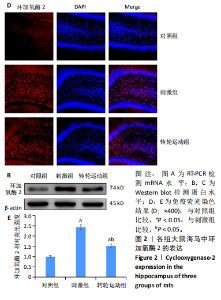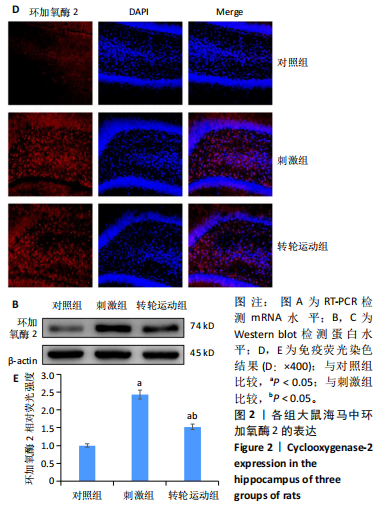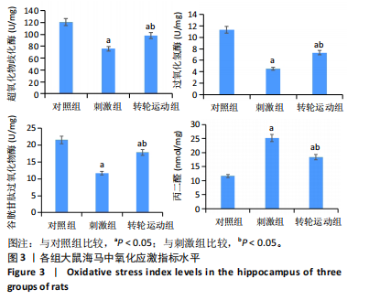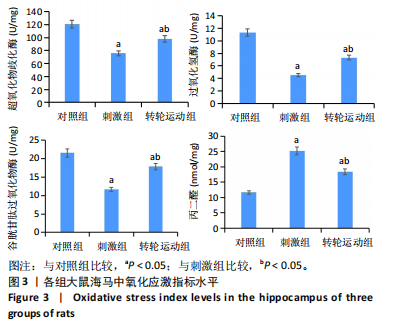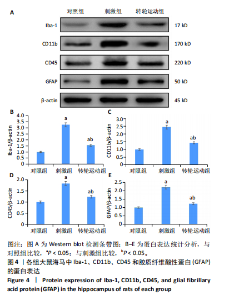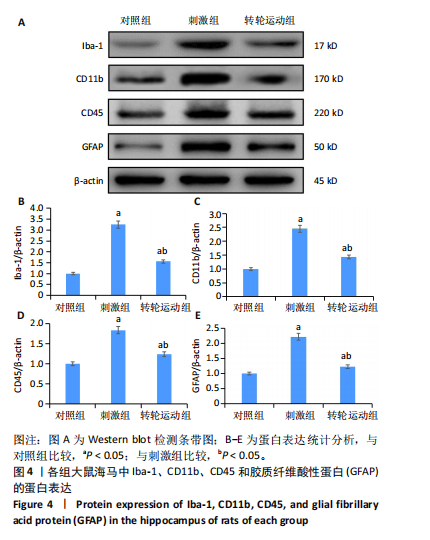Chinese Journal of Tissue Engineering Research ›› 2025, Vol. 29 ›› Issue (29): 6243-6248.doi: 10.12307/2025.779
Previous Articles Next Articles
Effects of exercise on activation of microglia and astrocytes and neuronal apoptosis in depressed rats
Du Juan1, Zhang Yi1, Hao Quanshui2
- 1School of Physical Education, Jianghan University, Wuhan 430056, Hubei Province, China; 2Huanggang Central Hospital Affiliated to Yangtze University, Huanggang 438000, Hubei Province, China
-
Received:2024-09-05Accepted:2024-11-02Online:2025-10-18Published:2025-03-07 -
Contact:Zhang Yi, MS, Associate professor, School of Physical Education, Jianghan University, Wuhan 430056, Hubei Province, China -
About author:Du Juan, MS, Lecturer, School of Physical Education, Jianghan University, Wuhan 430056, Hubei Province, China -
Supported by:Hubei Provincial Health Commission 2021-2022 Annual Research Project, No. WJ2021M084 (to HQS)
CLC Number:
Cite this article
Du Juan, Zhang Yi, Hao Quanshui. Effects of exercise on activation of microglia and astrocytes and neuronal apoptosis in depressed rats[J]. Chinese Journal of Tissue Engineering Research, 2025, 29(29): 6243-6248.
share this article
Add to citation manager EndNote|Reference Manager|ProCite|BibTeX|RefWorks
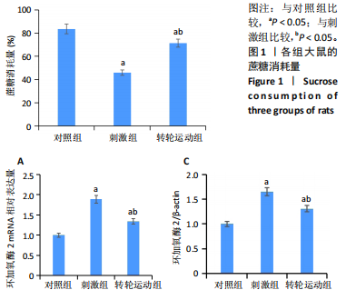
2.1 实验动物数量分析 造模成功的20只大鼠及正常对照组10只大鼠全部完成实验进入结果分析。 2.2 转轮运动改善了抑郁大鼠模型的抑郁样行为 与对照组相比,刺激组大鼠的蔗糖消耗量显著减少(P < 0.05)。表明慢性不可预测温和刺激大鼠缺乏快感,表现出抑郁的核心症状。然而,与刺激组相比,转轮运动组的蔗糖消耗量显著增加(P < 0.05),见图1。 2.3 转轮运动抑制了抑郁大鼠模型海马中环加氧酶2的表达 使用RT-PCR、Western blot和免疫荧光染色测定抑郁大鼠模型海马内的环加氧酶2表达。与对照组相比,在刺激组大鼠海马内环加氧酶2水平显著增加(P < 0.05);与刺激组相比,转轮运动组大鼠海马内的环加氧酶2表达显著降低(P < 0.05),见图2。 2.4 转轮运动抑制了抑郁大鼠模型海马的氧化应激 抑郁症通常伴有特定大脑区域的神经元损伤以及过量产生的活性氧,活性氧可导致衰老或细胞死亡。分析表明,与对照组相比,慢性不可预测温和刺激大鼠海马内抗氧化酶超氧化物歧化酶、过氧化氢酶和谷胱甘肽过氧化物酶的活性显著降低(P < 0.05),见图3。与对照组相比,刺激组大鼠的海马内观察到氧化应激产物丙二醛的水平升高(P < 0.05);与刺激组相比,转轮运动组大鼠海马内的超氧化物歧化酶、过氧化氢酶和谷胱甘肽过氧化物酶水平显著增加,而丙二醛水平显著降低(P < 0.05)。 2.5 转轮运动抑制了抑郁大鼠模型海马的神经胶质细胞活化 与对照组相比,刺激组大鼠海马的Iba1蛋白表达水平显著增加(P < 0.05),并且小胶质细胞标记物CD11b和CD45蛋白表达水平显著增加(P < 0.05),见图4。这些结果表明,慢性不可预测温和刺激诱导了大鼠海马内的小胶质细胞活化。与刺激组相比,转轮运动组大鼠海马内的Iba1、CD11b和CD45蛋白表达水平显著降低(P < 0.05)。 星形胶质细胞的激活在神经炎症反应中也起着至关重要的作用。蛋白质印迹分析表明,刺激组大鼠海马胶质纤维酸性蛋白水平显著增加(P < 0.05);与刺激组相比,转轮运动组大鼠海马内的胶质纤维酸性蛋白水平显著降低(P < 0.05),见图4。 2.6 转轮运动抑制了抑郁大鼠模型海马中神经细胞凋亡 过量产生活性氧会导致细胞死亡或衰老。研究进一步检测了转轮运动是否可以调节慢性不可预测温和刺激大鼠的神经凋亡,与对照组相比,刺激组大鼠的海马内Bcl-2的蛋白表达水平显著降低,而Bax和cleaved caspase-3显著增加(P < 0.05);与刺激组相比,转轮运动组大鼠海马内的Bcl-2的蛋白表达水平显著升高,Bax和cleaved caspase-3降低(P < 0.05),见图5。"
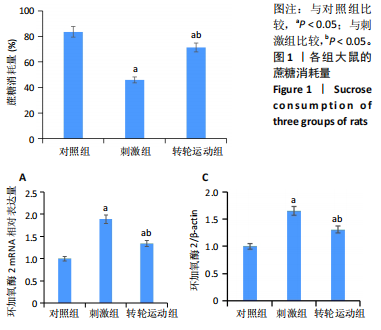
| [1] BORBÉLY É, SIMON M, FUCHS E, et al. Novel drug developmental strategies for treatment-resistant depression. Br J Pharmacol. 2022; 179(6):1146-1186. [2] FAN J, GUO F, MO R, et al. O-GlcNAc transferase in astrocytes modulates depression-related stress susceptibility through glutamatergic synaptic transmission. J Clin Invest. 2023;133(7):e160016. [3] TIAN P, CHEN Y, ZHU H, et al. Bifidobacterium breve CCFM1025 attenuates major depression disorder via regulating gut microbiome and tryptophan metabolism: A randomized clinical trial. Brain Behav Immun. 2022;100:233-241. [4] HARSANYI S, KUPCOVA I, DANISOVIC L, et al. Selected Biomarkers of Depression: What Are the Effects of Cytokines and Inflammation?. Int J Mol Sci. 2022;24(1):578. [5] REYES-MARTÍNEZ S, SEGURA-REAL L, GÓMEZ-GARCÍA AP, et al. Neuroinflammation, Microbiota-Gut-Brain Axis, and Depression: The Vicious Circle. J Integr Neurosci. 2023;22(3):65. [6] WANG H, HE Y, SUN Z, et al. Microglia in depression: an overview of microglia in the pathogenesis and treatment of depression. J Neuroinflammation. 2022;19(1):132. [7] ADELEKE PA, AJAYI AM, BEN-AZU B, et al. Involvement of oxidative stress and pro-inflammatory cytokines in copper sulfate-induced depression-like disorders and abnormal neuronal morphology in mice. Naunyn Schmiedebergs Arch Pharmacol. 2023;396(11):3123-3133. [8] JI N, LEI M, CHEN Y, et al. How Oxidative Stress Induces Depression? . ASN Neuro. 2023;15:17590914231181037. [9] LIU H, DU Y, LIU LL, et al. Anti-depression-like effect of Mogroside V is related to the inhibition of inflammatory and oxidative stress pathways. Eur J Pharmacol. 2023;955:175828. [10] SHEN J, HAO C, YUAN S, et al. Acupuncture alleviates CUMS-induced depression-like behaviors of rats by regulating oxidative stress, neuroinflammation and ferroptosis. Brain Res. 2024;1826:148715. [11] MÜLLER N, SCHWARZ MJ. COX-2 inhibition in schizophrenia and major depression. Curr Pharm Des. 2008;14(14):1452-1465. [12] SONG Q, FENG YB, WANG L, et al. COX-2 inhibition rescues depression-like behaviors via suppressing glial activation, oxidative stress and neuronal apoptosis in rats. Neuropharmacology. 2019;160:107779. [13] DE OLIVEIRA LRS, MACHADO FSM, ROCHA-DIAS I, et al. An overview of the molecular and physiological antidepressant mechanisms of physical exercise in animal models of depression. Mol Biol Rep. 2022;49(6):965-4975. [14] KUNUGI H. Depression and lifestyle: Focusing on nutrition, exercise, and their possible relevance to molecular mechanisms. Psychiatry Clin Neurosci. 2023;77(8):420-433. [15] LIU R, ZHOU H, QU H, et al. Effects of aerobic exercise on depression-like behavior and TLR4/NLRP3 pathway in hippocampus CA1 region of CUMS-depressed mice. J Affect Disord. 2023;341:248-255. [16] 崔建梅, 苏晓云, 王昕, 等. 自愿转轮运动对抑郁模型大鼠行为学、脑组织神经Y肽及中央杏仁核一氧化氮合酶表达的影响[J]. 体育科学,2014,34(5):15-22. [17] MAO QQ, IP SP, KO KM, et al. Peony glycosides produce antidepressant-like action in mice exposed to chronic unpredictable mild stress: effects on hypothalamic-pituitary-adrenal function and brain-derived neurotrophic factor. Prog Neuropsychopharmacol Biol Psychiatry. 2009;33(7):1211-1216. [18] 沈一维, 律峰, 黎平, 等. 氯胺酮联合氟西汀对抑郁大鼠前额叶nNOS及其配体CAPON表达的影响[J]. 中国药理学通报,2015,31(4):487-492. [19] 李刚. 基于行为学的自由转轮运动抗实验性抑郁研究[J]. 武汉体育学院学报,2013,47(7):71-74. [20] HWANG IK, YI SS, YOO KY, et al. Effects of treadmill exercise on cyclooxygenase-2 in the hippocampus in type 2 diabetic rats: correlation with the neuroblasts. Brain Res. 2010;1341:84-92. [21] SONG Q, FAN C, WANG P, et al. Hippocampal CA1 βCaMKII mediates neuroinflammatory responses via COX-2/PGE2 signaling pathways in depression. J Neuroinflammation. 2018;15(1):338. [22] BANSAL Y, KUHAD A.Mitochondrial Dysfunction in Depression.Curr Neuropharmacol. 2016;14(6):610-618. [23] CHEN H, LU M, LYU Q, et al. Mitochondrial dynamics dysfunction: Unraveling the hidden link to depression. Biomed Pharmacother. 2024;175:116656. [24] DANG R, WANG M, LI X, et al. Edaravone ameliorates depressive and anxiety-like behaviors via Sirt1/Nrf2/HO-1/Gpx4 pathway. J Neuroinflammation. 2022;19(1):41. [25] FU Q, QIU R, CHEN L, et al. Music prevents stress-induced depression and anxiety-like behavior in mice. Transl Psychiatry.2023;13(1): 317. [26] BHATT S, NAGAPPA AN, PATIL CR. Role of oxidative stress in depression. Drug Discov Today. 2020;25(7):1270-1276. [27] FILAIRE E, ROUVEIX M, MASSART A, et al. Lipid peroxidation and antioxidant status in rat: effect of food restriction and wheel running. Eur J Appl Physiol. 2009;107(2):243-250. [28] GUO B, ZHANG M, HAO W, et al. Neuroinflammation mechanisms of neuromodulation therapies for anxiety and depression. Transl Psychiatry. 2023;13(1):5. [29] FUJII C, ZORUMSKI CF, IZUMI Y. Endoplasmic reticulum stress, autophagy, neuroinflammation, and sigma 1 receptors as contributors to depression and its treatment. Neural Regen Res. 2024;19(10):2202-2211. [30]JI C, TANG Y, ZHANG Y, et al. Microglial glutaminase 1 deficiency mitigates neuroinflammation associated depression. Brain Behav Immun. 2022;99:231-245. [31] HAN Q, LI W, CHEN P, et al. Microglial NLRP3 inflammasome-mediated neuroinflammation and therapeutic strategies in depression. Neural Regen Res. 2024;19(9):1890-1898. [32] LIU L, TANG J, LIANG X, et al. Running exercise alleviates hippocampal neuroinflammation and shifts the balance of microglial M1/M2 polarization through adiponectin/AdipoR1 pathway activation in mice exposed to chronic unpredictable stress. Mol Psychiatry. 2024; 29(7):2031-2042. [33] YANG P, CHEN H, WANG T, et al. Electroacupuncture attenuates chronic inflammatory pain and depression comorbidity by inhibiting hippocampal neuronal apoptosis via the PI3K/Akt signaling pathway. Neurosci Lett. 2023;812:137411. [34] ZHOU Z, YE Q, REN H, et al. CircDYM attenuates microglial apoptosis via CEBPB/ZC3H4 axis in LPS-induced mouse model of depression.Int J Biol Macromol. 2024;254(Pt 3):127922. [35] KO YJ, KO IG. Voluntary Wheel Running Improves Spatial Learning Memory by Suppressing Inflammation and Apoptosis via Inactivation of Nuclear Factor Kappa B in Brain Inflammation Rats. Int Neurourol J. 2020;24(Suppl 2):96-103. |
| [1] | Zhao Jiyu, Wang Shaowei. Forkhead box transcription factor O1 signaling pathway in bone metabolism [J]. Chinese Journal of Tissue Engineering Research, 2025, 29(9): 1923-1930. |
| [2] | Chi Wenxin, Zhang Cunxin, Gao Kai, Lyu Chaoliang, Zhang Kefeng. Mechanism by which nobiletin inhibits inflammatory response of BV2 microglia [J]. Chinese Journal of Tissue Engineering Research, 2025, 29(7): 1321-1327. |
| [3] | He Longcai, Song Wenxue, Ming Jiang, Chen Guangtang, Wang Junhao, Liao Yidong, Cui Junshuan, Xu Kaya. An experimental method for simultaneous extraction and culture of primary cortical neurons and microglial cells from SD rats [J]. Chinese Journal of Tissue Engineering Research, 2025, 29(7): 1395-1400. |
| [4] | Zhao Ruihua, Chen Sixian, Guo Yang, Shi Lei, Wu Chengjie, Wu Mao, Yang Guanglu, Zhang Haoheng, Ma Yong. Wen-Shen-Tong-Du Decoction promoting spinal cord injury repair in mice [J]. Chinese Journal of Tissue Engineering Research, 2025, 29(6): 1118-1126. |
| [5] | Liu Zhezhe, Yu Meiqing, Wang Tingting, Zhang Min, Li Baiyan. Troxerutin modulates nuclear factor-kappaB signaling pathway to inhibit brain injury and neuronal apoptosis in cerebral infarction rats [J]. Chinese Journal of Tissue Engineering Research, 2025, 29(6): 1137-1143. |
| [6] | He Guanghui, Yuan Jie, Ke Yanqin, Qiu Xiaoting, Zhang Xiaoling. Hemin regulates mitochondrial pathway of oxidative stress in mouse chondrocytes [J]. Chinese Journal of Tissue Engineering Research, 2025, 29(6): 1183-1191. |
| [7] | He Bo, Chen Wen, Ma Suilu, He Zhijun, Song Yuan, Li Jinpeng, Liu Tao, Wei Xiaotao, Wang Weiwei, Xie Jing . Pathogenesis and treatment progress of flap ischemia-reperfusion injury [J]. Chinese Journal of Tissue Engineering Research, 2025, 29(6): 1230-1238. |
| [8] | Lu Ranran, Zhou Xu, Zhang Lijie, Yang Xinling. Dimethyl fumarate alleviates nerve damage in a mouse model of Parkinson’s disease [J]. Chinese Journal of Tissue Engineering Research, 2025, 29(5): 989-994. |
| [9] | Sima Xinli, Liu Danping, Qi Hui. Effect and mechanism of metformin-modified bone marrow mesenchymal stem cell exosomes on regulating chondrocytes [J]. Chinese Journal of Tissue Engineering Research, 2025, 29(36): 7728-7734. |
| [10] | Zheng Yitong, Wang Yongxin, Liu Wen, Amujite, Qin Hu. Action mechanism of intrathecal transplantation of human umbilical cord mesenchymal stem cell-derived exosomes for repair of spinal cord injury under neuroendoscopy [J]. Chinese Journal of Tissue Engineering Research, 2025, 29(36): 7743-7751. |
| [11] | Shui Jing, He Yu, Jiang Nan, Xu Kun, Song Lijuan, Ding Zhibin, Ma Cungen, Li Xinyi. Astrocytes regulate remyelination in central nervous system [J]. Chinese Journal of Tissue Engineering Research, 2025, 29(36): 7889-7897. |
| [12] | Yu Hui, Yang Yang, Wei Ting, Li Wenli, Luo Wenqian, Liu Bin. Gadd45b alleviates white matter damage in chronic ischemic rats by modulating astrocyte phenotype [J]. Chinese Journal of Tissue Engineering Research, 2025, 29(36): 7797-7803. |
| [13] | Zhang Xiaoyu, Wei Shanwen, Fang Jiawei, Ni Li. Prussian blue nanoparticles restore mitochondrial function in nucleus pulposus cells through antioxidation [J]. Chinese Journal of Tissue Engineering Research, 2025, 29(34): 7318-7325. |
| [14] | Su Yongkun, Sun Hong, Liu Miao, Yang Hua, Li Qingsong. Development of novel antioxidants and antioxidant combination carried by nano-hydrogel systems in treatment of intervertebral disc degeneration [J]. Chinese Journal of Tissue Engineering Research, 2025, 29(34): 7376-7384. |
| [15] | Wu Qingyun, Su Qiang. Antioxidant nanomedicine-mediated targeted therapy for myocardial ischemia-reperfusion injury [J]. Chinese Journal of Tissue Engineering Research, 2025, 29(34): 7431-7438. |
| Viewed | ||||||
|
Full text |
|
|||||
|
Abstract |
|
|||||
